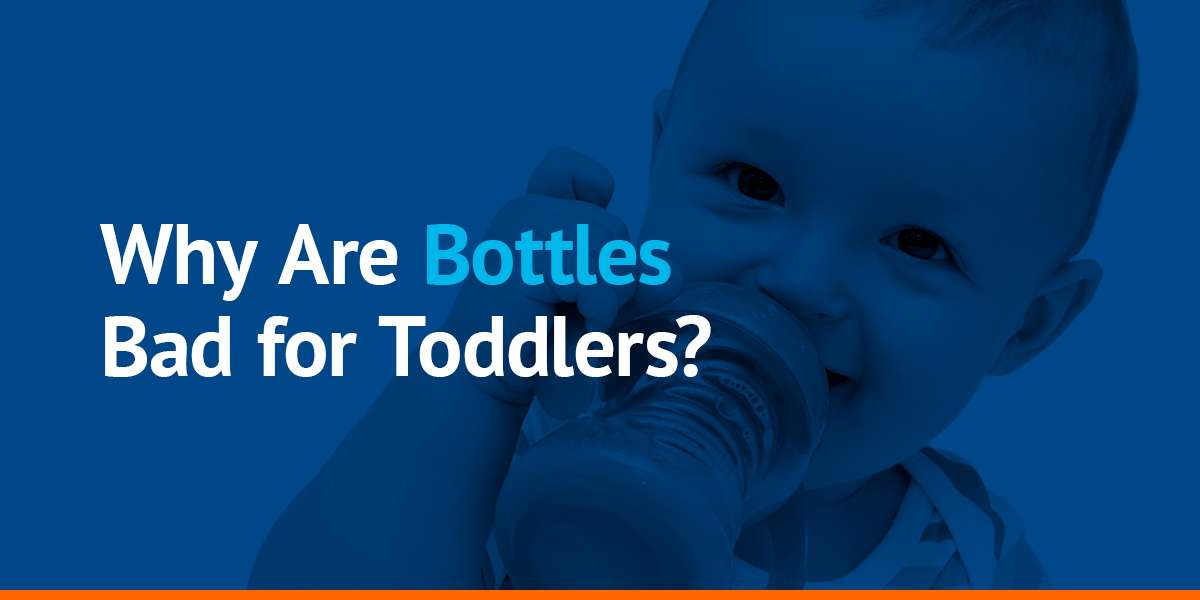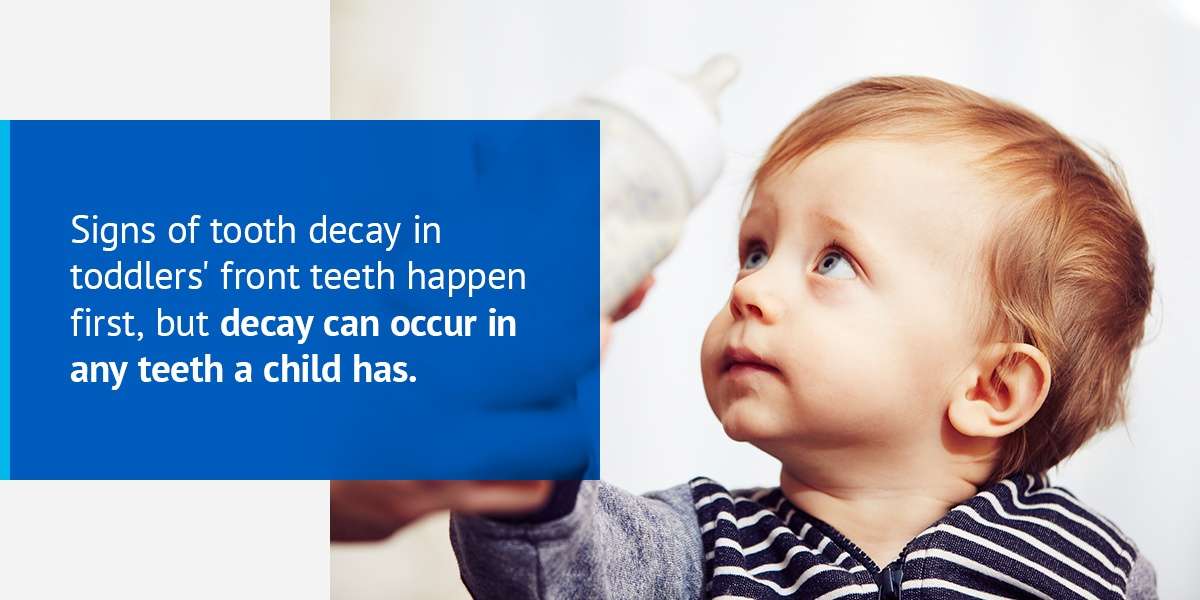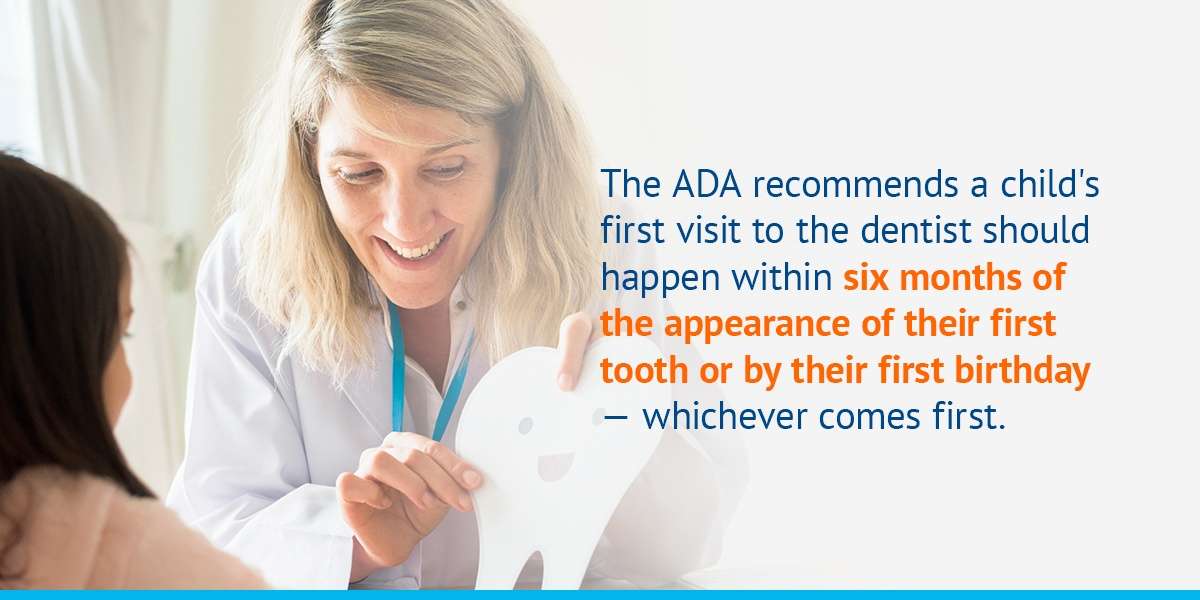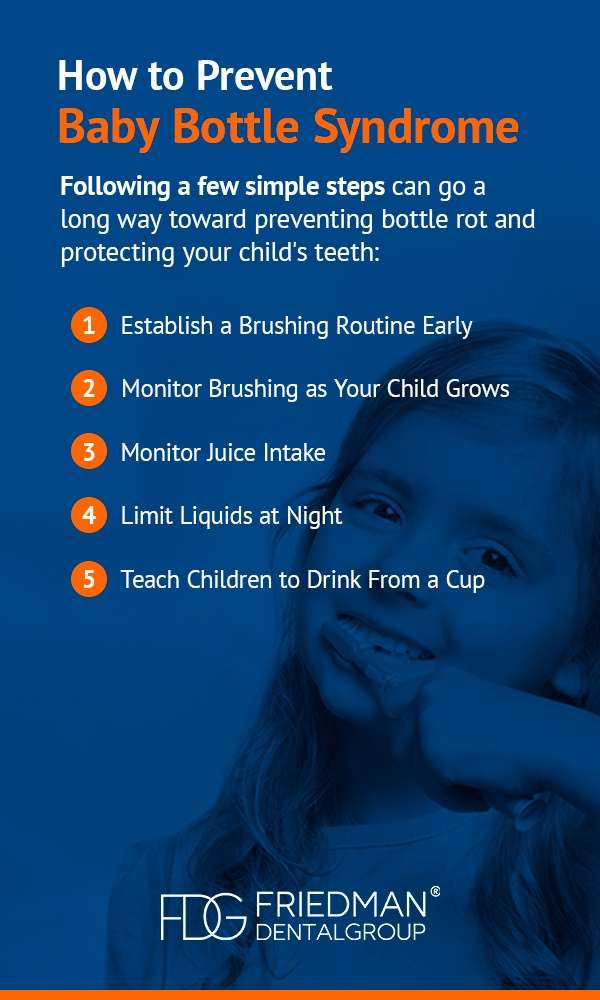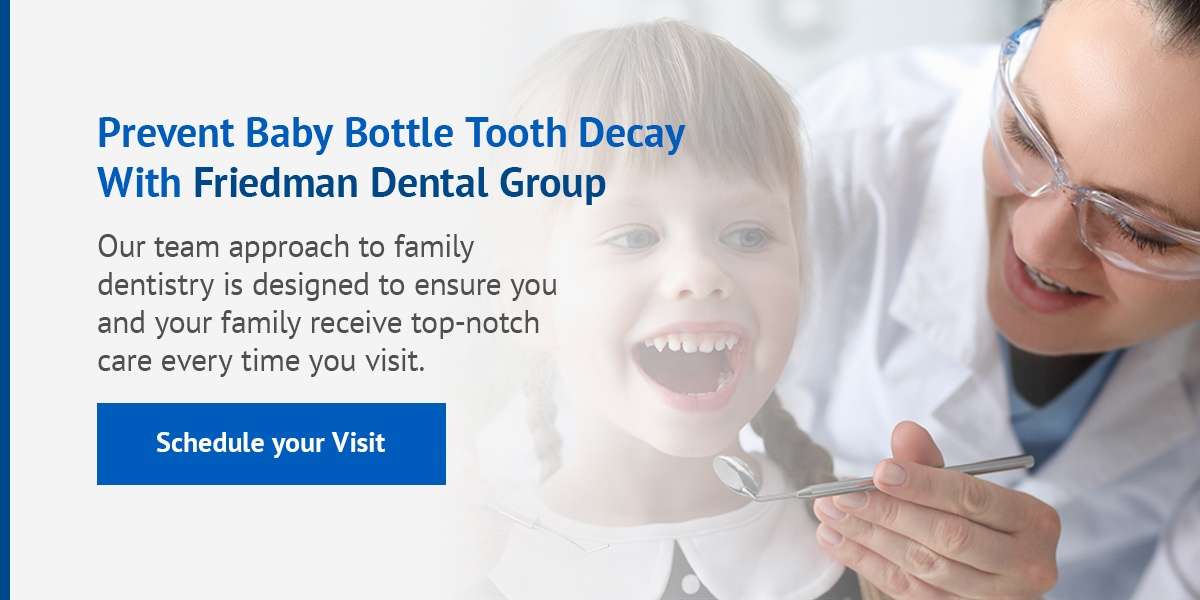Why Are Bottles Bad for Toddlers?
Tooth decay — which dentists refer to as “dental caries” — is the most common chronic childhood condition around the world. This condition is seven times more common than hay fever allergies, five times more common than asthma, and 20 times more likely to occur than juvenile diabetes.
Although any child can develop caries at any age, children who drink using bottles are uniquely susceptible to this problem starting as early as 6 months of age. When infants and young children drink sugary drinks like juice and milk from baby bottles, the sugars remain on their teeth and produce decay-causing bacteria. Over time, their baby teeth begin to form cavities. In some extreme cases, teeth may have to be extracted.
As a parent, it’s easy to take good oral health for granted, especially because baby teeth are temporary. The truth is that this condition can have a serious long-term impact on a child’s dental health. In fact, a child’s first months and years play a significant role in their lifelong journey toward good oral health.
What Is Baby Bottle Tooth Decay?
Baby bottle tooth decay refers to tooth decay that happens in the first few years of a child’s life. This condition happens when high-sugar liquids cling to a child’s teeth and produce excessive amounts of decay-causing bacteria. Frequently, signs of tooth decay in toddlers’ front teeth happen first, but decay can occur in any teeth a child has.
This condition has many different names, including:
- Bottle rot
- Early childhood caries (ECC)
- Baby bottle syndrome
- Nursing bottle syndrome
- Baby bottle mouth
One of the biggest differences between baby bottle tooth decay and tooth decay in older children and adults is that this early condition frequently stems from the consumption of formula, fruit juices, and milk. Everyone has bacteria in their mouths, but when those bacteria are exposed to the sugars in these liquids, they multiply and form an acid that wears away at tooth enamel. Over time, the enamel is worn away enough that decay and cavities form.
Sometimes parents mistakenly believe their child’s oral health doesn’t matter because they only have a handful of teeth and their baby teeth will eventually fall out. But baby teeth are more than placeholders for permanent teeth. Baby teeth have an important role to play in a child’s health and development by:
- Helping chew food properly so a child can get the nutrition they need for healthy development.
- Assisting in proper speech and word formation.
- Forming the shape of a child’s face.
- Maintaining the proper spacing in the mouth for larger permanent teeth, thereby preventing misaligned or poorly spaced adult teeth.
What Causes Baby Bottle Tooth Decay?
To prevent problems with bottle tooth decay, it’s important to understand baby bottle tooth decay causes. We’ve discussed that tooth decay happens when bacteria in the mouth produce an acidic substance that wears away at tooth enamel. The following are specific practices that can lead to early childhood caries:
1. Consumption of Juice and Milk
Babies and young children who rely on bottles to consume juice and milk are at an especially high risk for tooth decay. When a child drinks from a bottle, especially at naptime and bedtime, they often drink slowly, and some of the liquid remains in their mouth after they fall asleep. Even once they stop sucking on the bottle, some of the liquid will remain in their mouth. The body produces less saliva during sleep, reducing its ability to wash away the sugars left behind.
Milk is an important component of a young child’s diet. But as babies grow and become toddlers, it’s important to teach them to drink milk during their waking hours and to consume it from a cup. According to the American Academy of Pediatrics, approximately 4 ounces to 6 ounces of juice is acceptable. This juice should always be mixed with water to dilute the amount of sugar a child is consuming and should never be given to children at bedtime or naptime.
2. Dipping Pacifiers in Sugary Substances
While your child may enjoy sucking on a pacifier coated in syrup or juice, exposing their young teeth to these high levels of sugar can lead to decay. Just like drinking sugary drinks, these substances linger in the mouth and on the teeth, encouraging bacteria growth and tooth decay. If your child relies on a pacifier for comfort, avoid putting anything on it and wash it frequently to prevent residual milk and juice sugars from being transferred from their mouth to the pacifier and back again.
3. Relying on a Bottle After Age 1
Sucking on bottles and pacifiers is comforting for infants. So why are bottles bad for toddlers? It’s common for parents to get into a habit of relying on a bottle or pacifier to comfort their child, and they may allow kids to use these items long after they are necessary.
Because of the risk of tooth decay, the American Dental Association (ADA) recommends parents aim to transition their child from a bottle to a cup around the time they reach their first birthday. Drinking from a cup rather than a bottle discourages slow sipping over time and prevents children from falling asleep with liquids in their mouth. Children who remain attached to these items may need to be weaned off gently. The weaning should happen by replacing sugary liquids with water in the bottle, especially at naptime and bedtime.
Symptoms of Bottle Rot
Symptoms of bottle rot can begin long before a child feels pain or discomfort. Since many young children don’t have the verbal skills necessary to communicate a problem, it’s important for parents to be vigilant and watch their child’s teeth closely for symptoms of tooth decay. The early signs of tooth decay in toddlers are white spots on the surface of a child’s tooth. At this phase, the decay is new enough that it can be addressed quickly and simply. If you catch it early enough, decay can be reversed, and the surface of the tooth can be rebuilt.
If decay is not detected or addressed at this early stage, advanced symptoms may include:
- Swollen or bleeding gums
- Brown or black spots on teeth
- Bad breath
- Signs of infection, such as irritability, fever, or swelling
If you notice any of these signs, even if it’s just one tooth, it’s important to consult a dentist immediately. The sooner decay is detected, the easier it will be to treat the problem and prevent more serious problems from arising.
The ADA recommends a child’s first visit to the dentist should happen within six months of the appearance of their first tooth or by their first birthday — whichever comes first. Establishing an early habit of regular dental checkups is a great way for parents to have support as they monitor their child’s oral health. A family dental practice is skilled in the early detection of infant caries and can help parents address and prevent a variety of potential complications.
Treatments for Infant Caries
If you suspect your child is suffering from baby bottle syndrome, it’s important to schedule a consultation with a dentist as soon as possible. Baby tooth decay treatments can vary, depending on how severe the problem is. In most cases, tooth decay in children is treated the same way it is treated in adults, using stainless steel crowns to seal the tooth so the bacteria can no longer access the tooth. Many times, young children will need to undergo sedation or general anesthesia for restoration work like this, especially if your child is too young to sit still or the required work is extensive.
If infant caries is left unaddressed and the decay is severe, the only baby bottle tooth decay treatment option left may be to pull the affected tooth or teeth. This is typically done as a last resort if restoration work will not effectively address the problem. Tooth extraction is the last option because baby teeth are important placeholders for adult teeth.
If a tooth is extracted, the dentist may place a spacer in the place where the tooth was housed to save that space for the permanent tooth that will come later. Failure to save this space may cause overcrowding or other difficulties with permanent teeth, resulting in more dental and orthodontic work and repair costs.
How to Prevent Baby Bottle Syndrome
Baby bottle tooth decay can cause serious problems, but it’s also one of the easiest childhood conditions to prevent. Following a few simple steps can go a long way toward preventing bottle rot and protecting your child’s teeth:
1. Establish a Brushing Routine Early
Don’t wait to establish a brushing routine until your child has a mouthful of teeth. After each feeding, take a warm washcloth or clean gauze and gently wipe your infant’s gums. Once your child’s teeth begin to erupt through the gums, begin brushing their teeth two to three times a day. Your local drugstore likely carries toothbrushes for young children, and you can consult the packaging to determine which brush is right for your child. At this stage, it’s not necessary to use toothpaste, but if you want to use it, be sure to select something flouride-free.
2. Monitor Brushing as Your Child Grows
Once all your child’s teeth are in, begin teaching them to brush their teeth themselves. Young children need to be monitored to ensure they’re brushing properly and reaching all the teeth in the sides and back of their mouths. This is also an excellent time to start teaching them how to floss. If traditional string floss is too difficult for their small fingers, you can purchase kid-friendly flossers that come pre-strung with floss.
By this age, you should continue scheduling regular dental checkups. A family dentist can help monitor your child’s teeth and detect problems early on. They can also advise you on when to begin using a flouride-based toothpaste during morning and evening brushing sessions.
3. Monitor Juice Intake
Juices that contain 100% fruit juice do have a place in a child’s diet, as long as they’re consumed in moderation. The best way to limit a child’s juice intake is to use juice as a treat, rather than a staple. When your child does drink juice, water it down to decrease the amount of sugar they’re consuming. Encourage water and milk consumption over juice.
4. Limit Liquids at Night
It’s common for children to want a drink at bedtime, especially if they’re young and accustomed to drinking a bottle or nursing before bedtime. Once it’s age-appropriate to stop pre-bedtime feedings, limit evening liquid consumption to water only.
5. Teach Children to Drink From a Cup
Many parents transition their child from a bottle to a sippy cup and then stop. Sippy cups are meant to help with the transition from a bottle to a traditional cup. When parents stop the transition at a sippy cup, their child is still at risk for bottle tooth decay. This is because many sippy cups, especially those with valves, are technically versions of a baby bottle because a child has to suck on them to get liquid out. Sippy cups continue the risk of infant caries by allowing sugars to linger on near a child’s teeth.
The best sippy cups are ones that don’t have a valve, and these should only be used to help transition children from a bottle to a cup. The best training cups are ones that have a screw-on lid with a spout. As you teach your child to use this cup, also teach them that most liquids — other than water — should only be consumed at mealtime. Eating increases saliva production, which means that sugars consumed at mealtime are less likely to linger on a child’s teeth.
Bottle-Feeding Tips
If your child is young enough to still require a bottle, there are several steps you can take to reduce their risk of developing baby bottle mouth:
1. Bottles Are Only for Feeding
Though babies find sucking on a bottle soothing, resist the urge to use a bottle and the liquid in it for soothing purposes — especially at bedtime. When your child is drinking from a bottle, stay with them, even if they’re old enough to hold the bottle on their own. When the liquid inside is gone, take the bottle from them and gently wipe their gums. If it’s naptime or bedtime, offer them a pacifier if they still need to be soothed.
2. Bottles Are Only for Milk and Water
Avoid placing juice in a baby’s bottle. Reserve juice for older children who can use a training cup or regular cup. Many parents find the sweetness of juice helps them as they encourage their child to transition from bottle to cup because it’s something their child hasn’t tasted before. An exception to this rule is in cases of illness if your child needs to consume an electrolyte solution to prevent dehydration. Your child’s pediatrician can advise you on the best way to administer this.
3. Bottles Are Only for Babies
Ideally, children should transition from a bottle to a cup by their first birthday. At this point, they should have the motor skills needed to navigate a training cup and will get most of their nutrition from food they can eat with their hands. There is a strong correlation between bottle feeding and teeth alignment, meaning the longer a child uses a bottle, the greater the chance it may impact the alignment of their teeth. If a child still seeks the comfort of a bottle at naptime or bedtime, encourage the use of a pacifier or stuffed animal.
Learn How to Prevent Baby Bottle Tooth Decay With Friedman Dental Group
At the Friedman Dental Group, we believe the best dental experience happens when dentists listen to their patients and partner with them to provide quality care. Our team approach to family dentistry is designed to ensure you and your family receive top-notch care every time you visit. Our spa-like setting is complete with noise-canceling headphones, an espresso bar, and hot towels so you can relax knowing you’re in capable hands. Schedule your visit today.
Last Reviewed By Dr. Eli Friedman on December 18, 2020
